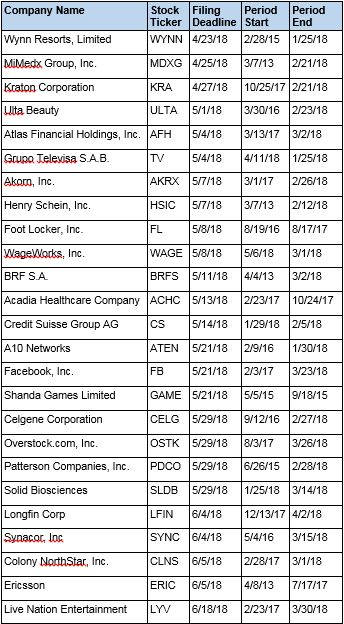Ericsson Class Action Report
Levi & Korsinsky, LLP
April 20, 2018
On April 5, 2018, investors sued Telefonaktiebolaget LM Ericsson (“Ericsson” or the “Company” in United States District Court, Southern District of New York. Plaintiffs in the federal securities class action allege that they acquired Ericsson’s American Depository Shares (“ADS”) at artificially inflated prices between April 8, 2013 and July 17, 2017 (the “Class Period”). They are now seeking compensation for financial losses incurred upon public revelation of the Company’s alleged misconduct during that time. Here’s everything you need to know about the Ericsson class action lawsuit:
Summary of the Allegations
Company Background
According to its website, the Company (NASDAQ: ERIC) is “one of the leading providers of Information and Communication Technology (ICT) to service providers” with networks that carry approximately 40 percent of the world’s mobile traffic.
Ericsson provides services including but not limited to systems integration, network rollouts and consulting projects “that are often structured as multi-year contracts.”
According to the April 5, complaint, revenue generated from those services was included in the Company’s Global Services segment until 2016, when Ericsson changed its reporting structure. Starting that year, these revenues were split between the “new” Networks and IT & Cloud segments. In 2016, the Networks, IT & Cloud and Media segments respectively accounted for 74 percent, 22 percent and 4 percent of Ericsson’s total revenue.
Summary of Facts
Ericsson and five of its current and/or formers officers and directors now stand accused of deceiving investors by lying and withholding critical facts about the Company’s business practices during the Class Period.
Specifically, they are accused of omitting truthful information about recognition of revenue and recognition of certain costs from SEC filings and related material. By knowingly or recklessly doing so, they allegedly caused Ericsson’s ADS to trade at artificially inflated prices.
The truth came out in a series of disclosures made by the Company between April 21, 2016 and July 18, 2017. In each case, Ericsson attributed poor financial performance to weak revenue from service projects, including “certain large customer projects.”
In the last disclosure, made during an earnings call on July 18, 2017, the Company admitted that it had identified more than 40 “long-term service contracts to date with total annual sales of almost $1 billion that Ericsson would exit, renegotiate or transform.”
A closer look…
As alleged in the April 5 complaint, the Company repeatedly made misleading public statements during the Class Period.
For example, on a form filed with the SEC on April 8, 2014, the Company said in pertinent part: “Our focus on profitability is now starting to pay off, with stable margins in Professional Services and a steady improvement in Networks during the year. Operating income was up from SEK 10.5 billion in 2012 to SEK 17.8 billion in 2013, with our operating margin increasing from 5 % to 8%.”
On another form filed with the SEC on March 31, 2015, the Company said in pertinent part: “There was continued momentum for Professional Services with double-digit sales growth during the second half of the year.”
Finally, on a form filed with the SEC on April 4, 2016, the Company said in pertinent part: “Professional Services reported sales grew 15% with strong development across the portfolio an with growth in all ten regions…”
Impact of the Alleged Fraud on Ericsson’s Stock Price and Market Capitalization
| Closing stock price prior to disclosures:
|
$7.28 |
| Closing stock price the trading day after disclosures:
|
$6.07 |
| One day stock price decrease (percentage) as a result of disclosures:
|
16.62% |
The following chart illustrates the stock price during the class period:
Actions You May Take
If you have purchased shares during the Class Period, you may join the class action as a lead plaintiff, remain a passive class member, or opt out of this litigation and pursue individual claims that may not be available to the class as a whole.
NOTE: The deadline to file for lead plaintiff in this class action is June 5, 2018. You must file an application to be appointed lead plaintiff prior to this deadline in order to be considered by the Court. Typically, the plaintiff or plaintiffs with the largest losses are appointed lead plaintiff.
In order to identify your potential exposure to the alleged fraud during the time in question, you may wish to perform an analysis of your transactions in Ericsson common stock using court approved loss calculation methods.
Recently Filed Cases
Listed below are recently filed securities class action cases being monitored by us, along with the class period and the deadline to file a motion to be appointed as the Lead Plaintiff in the action. Please contact us if you would like an LK report for any of these cases:
About Us
| This information is provided for general information purposes only, and should not be construed as legal advice, nor does it establish an attorney-client relationship with Levi & Korsinsky LLP. Any and all information herein is simply an opinion based on publicly available information and should not necessarily be construed as fact. For more information, please visit our website at www.zlk.com.
Attorney Advertising
|
Levi & Korsinsky is a leading securities litigation firm with a hard-earned reputation for protecting investors’ rights and recovering losses arising from fraud, mismanagement and corporate abuse. With thirty attorneys and offices in New York, Connecticut, California and Washington D.C., the firm is able to litigate cases in various jurisdictions in the U.S., England, and in other international jurisdictions.
Levi & Korsinsky provides portfolio monitoring services for high-net worth investors and institutional clients. Our firm also assists investors in evaluating whether to opt-out of large securities class actions to pursue individual claims.
For additional information about this case or our institutional services, please contact us.
